Course Information

WELCOME TO YOUR JOURNEY
Outward Bound offers an exciting opportunity for you to learn new skills, make friends and create memories that will last a lifetime. Our mission? To change lives through challenge and discovery!
THIS IS YOUR COURSE INFORMATION PAGE: Please bookmark this for future reference. It is your “go to” location for all forms, gear lists and information specific to YOUR course.
COURSE PAPERWORK: To participate on Outward Bound, each applicant must submit all requested medical information, the signed risk and liability release form, and, if applicable, be interviewed by a Student Services Representative. Forms will be sent to you in your Registration Email. Make sure you refer to your Registration Email to determine what paperwork is required of you in order to move your application forward. You need the most current edition of Adobe Reader's free software in order to access and complete these forms.
> Directions on how to complete and submit your forms.
All applicants must adhere to the due dates listed in their Registration Email for payments and forms. If due dates are not met, you risk losing your position on course as well as your deposit.
We look forward to seeing you Outward Bound!
Alpine Backpacking
Alpine Backpacking will develop a foundational outdoor skillset for students allowing comfortable living during course. Traveling mostly above treeline, students will carry everything they need - food, shelter, clothing and gear – allowing them to go deep into the wilderness where few people go. Backpacking provides a sense of freedom, allowing students to eat when hungry, set up camp when tired, and exercise complete control over what is accomplished each day. The simplicity of backpacking gives students the opportunity to focus both internally on their own thoughts, as well as externally to connect deeply with others as they talk, sing, play games and spend time together without distraction. With the Rocky Mountains as a backdrop, students are introduced to backpacking with lessons in basic travel and camping techniques. As this section progresses, students learn Leave No Trace techniques, map and compass navigation, camp craft, and obtain an understanding of the area’s human and natural history.
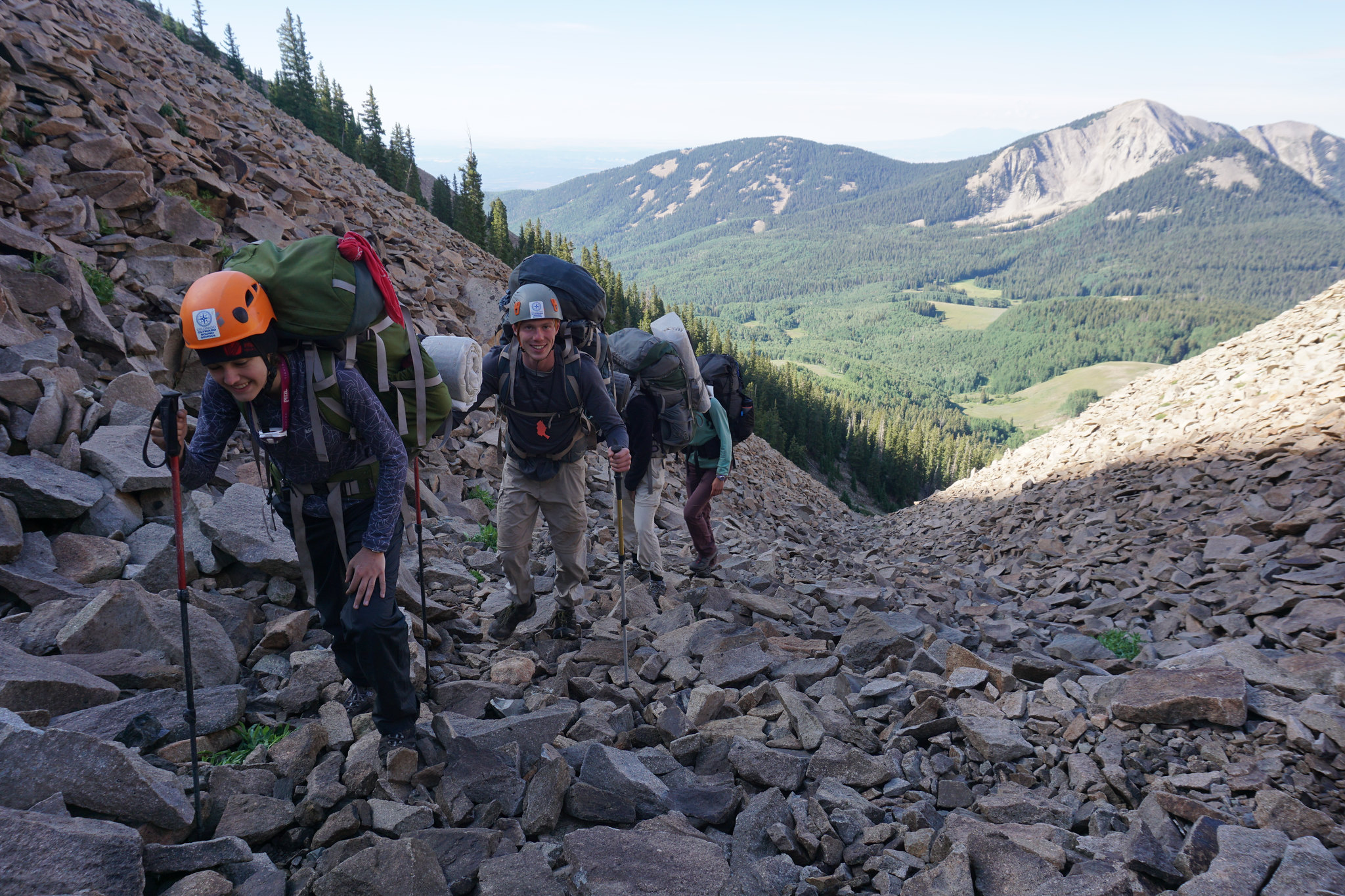
Photo: Dave Erbe |📍Núu-agha-tʉvʉ-pʉ̱ (Ute) lands
Rafting
On the river, each day is spent learning to navigate various obstacles and how to anticipate the forces of the current from upstream. You and your companions will work to become a team, coordinating your spacing and paddle strokes. You will have an opportunity to be the captain of your crew and put to use what you’ve learned as you maneuver your raft through Class 2-4 rapids. Interspersed between the rapids are flat-water sections where there is a current, but no whitewater. At times, you will take advantage of this calm water to hone your skills and enjoy the view. Time in a raft is ideal for getting to know each other and forming boat pride, laughing your way downriver as you relax into river life. Afternoons can bring strong up-canyon winds, which create a challenge as you dig in to reach the camping destination. Rafting connects you to the river: the oasis of flora and fauna (including humans!) that rely on the river to survive in the desert. The soaring canyons complement the roar of whitewater, as well as the silences that can only be found in such remote beauty.
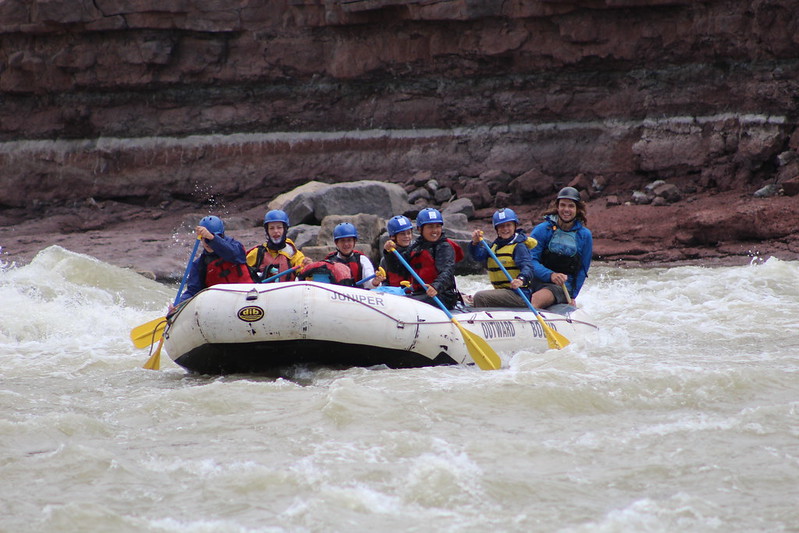
Photo: Curtis Huey |📍Núu-agha-tʉvʉ-pʉ̱ (Ute), Diné, and Pueblos lands
Guided Reflection and Transference
At Outward Bound we believe there is no learning without reflection. Throughout course, you will be prompted to reflect on what you’re experiencing on course, and what it means in the greater context of your life. Sometimes this is a journaling exercise, sometimes a group sharing experience, and sometimes a moment of solitude to sit and think. You spend focused time toward course progression end exploring how your new knowledge, skills and attributes can apply to your life after course.
Solo
Solo is a time when you’ll get the opportunity to spend time alone during course. With sufficient food and equipment, your Solo will be a chance to reflect on your course experience, journal, and connect with nature. Depending on your course length and environmental factors, Solo can range from 30 minutes to an overnight experience. You will not travel during this time and your Instructors may check on you occasionally. Your solo site will be close enough to your Instructors in case of emergency, but far enough removed to enjoy solitude. Many students are initially nervous about solo, but later recall it as one of the highlights of their course.
Service Project
Some projects focus on land restoration and are coordinated with partners and land managers like the US Forest Service, Bureau of Land Management and National Park Service. Other projects are grounded in social services, and may include visiting a nursing home or hospital. Past projects include working on a goat farm, building trails, cleaning trash and debris from natural spaces, working with a local community garden, and removing invasive species. Seeing the impact of their actions firsthand, students develop a value of service, and transfer this desire to serve their communities back home.
Our expeditions help students grow into the best version of themselves. We use adventure in the outdoors to help students discover their strengths and build authentic connections with their peers. Compassion for oneself and others is foundational to the Outward Bound experience. As students develop outdoor skills, they also gain confidence and leadership tools that will last a lifetime. Course outcomes include:
- Belonging – students form deep connections founded upon respect, inclusion, and compassion
- Reflection – students learn self-awareness and practice empathy towards others
- Physical Engagement – students develop awareness and confidence in their bodies
- Courage – students develop the confidence to speak up for themselves and persevere through challenges
Watch to Learn More
La Sal Mountains, Utah
The La Sal Mountains rise dramatically out of the desert, towering 9,000’ above the surrounding canyonlands and Moab. The La Sals are known for their groves of aspen, rich amount of wildlife, high summits, and incredible views overlooking Canyonlands and Arches National Park and the Four Corners area. Hidden lakes dot the landscape. Peaks in the La Sals range from ten thousand to just under thirteen thousand feet and include the highest mountains in Southern Utah. The La Sal Mountains are within the ancestral lands of the Ute.
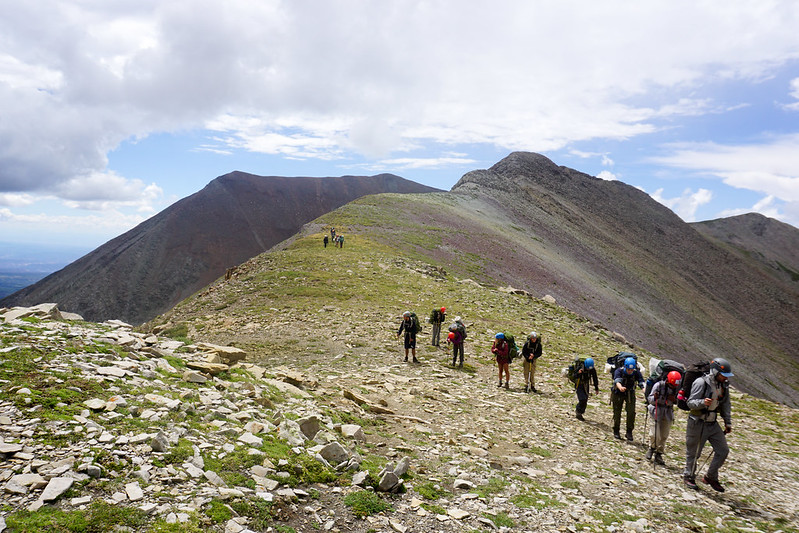
Photo: Dave Erbe |📍Ute lands
Desolation and Gray Canyons, Utah
Surrounded by the Tavaputs Plateau and bordered by the Uinta and Ouray Reservation on the east, the journey on the Green River begins in Desolation Canyon near Sand Wash. Throughout the canyon, there are spectacular rock formations, archaeological sites and abandoned ranches including McPherson Ranch, once frequented by Butch Cassidy's “Wild Bunch.” The tiered rock walls of Desolation give way to the earthy bluffs of Gray Canyon, creating a striking contrast that characterizes the next 25 miles of the journey.
On longer rafting courses you may continue your journey down the Green River through Labyrinth Canyon, where the river dives deep into the pink sandstone of the Navajo Formation which characterizes southeastern Utah and the Canyonlands area with narrow winding side canyons, orange Wingate cliffs, pinnacles and ledges. These regions are within the ancestral lands of the Ute and Diné Bikéyah nations.
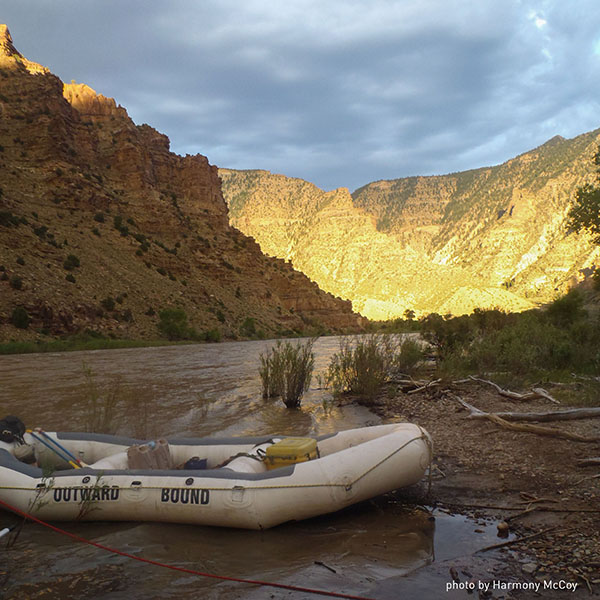
Photo: Harmony McCoy |Ute and Diné Bikéyah lands
What is a land acknowledgment?
At the Colorado Outward Bound School, we include land acknowledgments in our work as a formal way to recognize and respect the traditional territories and Indigenous Peoples as stewards of the land. It is important to understand and acknowledge the comprehensive past, present, and future of the places we travel and to seek to understand our role therein. To recognize the land is an expression of gratitude and appreciation we give to the Indigenous Peoples who have been living and working on the land from time immemorial. Read more about land acknowledgments at Outward Bound here.
The following is an example of what your itinerary may look like. Your actual course plan will vary according to weather, your group’s skills and abilities, and Instructor preferences.
Day 2-8: Rafting Desolation/Grey Canyons
Day 9: Potential Service Project, Re-supply, & Transfer
Day 10-14: Backpacking, Solo
Day 15: Group Challenge, Course End, and Transportation Home
Click here for COBS COVID-19 Program Practices
Tuition
You can pay your tuition online through your Applicant Portal or make the payment over the phone by calling 720-381-6589.
If your payment is not received by the due date listed in your Enrollment Email and on your Applicant Portal, you will risk losing your spot on course and your $500 deposit. Please review our Admissions and Cancellation Policies.
Travel Insurance
Airfare, travel costs, and non-refundable tuition payments are expensive. Insurance to protect your trip and course is strongly encouraged. We recommend insuring these costs from the third-party provider InsureMyTrip. This provider has coverage options that include travel costs and non-refundable tuition costs. For more information and to receive a free quote, click here.
Packing for backcountry travel is all about packing light and practically. Every day, you will be carrying all your gear, food, and water. So the lighter your load, the more comfortable you'll be! That's why we ask that students bring everything on the required gear list (and whatever you'd like to bring from the optional items list), but nothing more. Most experienced backcountry travelers will tell you that they bring about the same amount of gear on a three-day trip as they would on a three-week trip.
Important Packing Information
- Pack your clothing and gear in a duffel bag or suitcase. You will keep personal items such as clean clothes for your return trip home and valuables (cell phones, electronic devices, and wallets) in this bag while you are on course. Please leave unnecessary or expensive items at home.
- Once you arrive at base camp, your instructors will help you pack for backcountry travel. They will assess your personal gear, the group gear you will be required to carry, and help you adjust your pack as needed.
- We encourage you to leave the tags on any items you purchase for this course. That way, you may return these items if you do not use them on your expedition.
- Please bring everything on the list! If you have questions or concerns, we encourage you to reach out to your course advisor.
Medications:
- All prescription medications must be listed in the applicant’s medical record, must be approved by your course advisor prior to course, and must accompany the participant on course. Participants may not be permitted to begin their course without their required medications OR with new medications not approved by your course advisor.
- All medications (prescription, non-prescription, and OTC) must be in their original containers with the prescription label intact. The prescription label is documentation of the dosage directions. If possible, bring a double supply.
What to Wear While Travelling:
We recommend you wear course clothing and boots while travelling and bring all essentials (prescription meds, insurance card copy, cash) in a carry-on. This will minimize the inconvenience in the unlikely event your luggage is delayed in transport. Being dressed for course will also further the efficiency on your first day, especially since front country bathrooms and private changing areas are rarely available.
Gear that Outward Bound Provides
Outward Bound provides all other equipment that is not included on the required packing list. There are no additional fees for the use of our equipment. If you have your own equipment and it meets the criteria below, you are welcome to bring it with you. Your instructors may ask you to use Outward Bound gear in lieu of your own if it does not meet our criteria below.
If you do wish to bring some of your own gear, here are the standards for what may be acceptable
- Sleeping bags – need to be made from synthetic materials (down fill is not appropriate for our courses) and have a 20-degree or colder warmth rating.
- Sleeping pads – can be ¾ to full size in length. They can be closed-cell foam or inflatable. If you bring an inflatable pad please also bring a patch kit. Remember, inflatable pads often weigh considerably more than closed-cell foam pads.
- Backpacks – need to have a minimum capacity of 6,000 cubic inches, comfortably carry 45-60 lbs, and be an internal frame design.
If you bring your own equipment, it will be inspected by your instructor at the beginning of your course. If it does not meet our standards you can store it in a secure location during your course.
Layering:
- First layer—This layer is worn next to your skin. Synthetic and wool materials are best for this layer.
- Mid layer(s)— This is the insulation layer. Think thick tops, leggings, wool socks, and fleece jackets.
- Outer layer— This is the layer that will protect you from the wind, snow, and rain. Outer layers are completely waterproof not just water resistant.
Materials:
- Hard Shell: Waterproof and windproof, generally worn when it’s raining, snowing, or really windy.
- Soft Shell: Water and wind-resistant. Not waterproof but more breathable than hard-shell.
- Fleece: Great insulator and dries quickly.
- Wool: Natural material that, unlike cotton, keeps you warm when wet.
- Synthetic: Almost anything else but cotton! Acceptable non-cotton options are wool, capilene, poly-propylene, polyester, fleece, acrylic, rayon, Polartec, Thinsulate, COOLMAX, and nylon.
Still confused? Check out this video about fabrics from our friends at NCOBS.
Head & Hand Layers:
|
Quantity |
Item |
Description |
|
1 |
Baseball Cap |
Necessary for sun protection; full brimmed hats do not work well with backpacks. |
|
1 |
Warm Hat |
Wool or fleece beanie that can be worn under a helmet. |
|
1 |
Lightweight Gloves |
For sun and bug protection. |
|
1 |
Buff or bandana |
Personal preference. |
Top Layers:
|
Quantity |
Item |
Description |
|
3-4 |
Sports Bra |
Sports bra should be able to provide support in physical activity. |
|
2-3 |
Short Sleeve T-Shirts |
Basic synthetic layer that should be comfortable for both active and passive times on course. One cotton t-shirt for sleeping is optional. |
|
2-3 |
Long Sleeve Shirt |
UPF materials are recommended. Loosefitting, long sleeves. Long sleeve button up shirts and sun hoodies provide the best sun protection. |
|
1 |
Long Underwear Top |
Synthetic or wool, light to mid weight long underwear top. Important base layer, provides warmth and wicks sweat. |
|
1 |
Rain Jacket |
Should be waterproof, not water resistant. Should be helmet compatible and loosefitting as to go over all you other layers of clothes. |
|
1 |
Mid-Weight Fleece |
Breathable insulation for aerobic activities and provides insulation when wet. |
Bottom Layers:
|
Quantity |
Item |
Description |
|
3-5 |
Underwear |
Comfortable underwear for physical activities(synthetic or wool). Cotton underwear is recommended for sleeping (bring at least one pair). |
|
1-2 |
Shorts |
Athletic shorts that wick moisture and dry quickly. |
|
1 |
Hiking Pants |
Medium weight, loose fitting pant; These will be your most used pants. |
|
1 |
Long Underwear Bottoms |
Synthetic or wool, light to mid weight long underwear bottoms. Important base layer, provides warmth and wicks sweat. |
|
1 |
Medium Weight Fleece Pants |
These pants are useful in the backcountry. For keeping warm at camp on cool days and evenings, great for layering. |
|
1 |
Rain Pants |
Should be waterproof, not water resistant. Should be loosefitting as to go over all you other layers of pants. Lower leg zippers recommended. |
Footwear Layers:
|
Quantity |
Item |
Description |
|
3-4 |
Hiking Socks |
Basic wool hiking sock; crew to ski-length socks |
|
2-3 |
Thick Hiking Socks |
Important for very cold days, sleeping, and being at camp. Make sure new boots are fitted with the thickest socks |
|
1 |
Boots |
The most essential piece of gear that you will purchase. Must be waterproof, have good tread, a sturdy non-flexible sole, and at least mid-ankle in height. * Please read this blog on choosing boots for more information. Leather boots are NOT recommended for this course. |
|
1 |
Camp Shoes |
Comfortable shoe to wear around camp, should be lightweight, crocs are a great option (no flip flops). |
|
1 |
River Shoes |
Must be secure with sturdy sole and heel strap (no crocs or flip flops) and comfortable for short hikes. Chacos, Tevas and old sneakers are all excellent. |
Toiletries:
|
Quantity |
Item |
Description |
|
1 |
Waterproof Sunscreen |
SPF 30 or greater. For courses 15 days or longer, consider bringing a small bottle to carry and a larger bottle to resupply from. |
|
1 |
Lip Balm |
SPF 30 or greater. Important to protect from cracked lips. |
|
1 |
Moisturizing Lotion |
Important for desert conditions, even if you don't usually have dry skin! 4-6 Oz. per week. |
|
1 |
Toothbrush & Toothpaste |
Travel Size toothpaste can help save room and weight in a backpack. No electric toothbrushes. |
|
|
Menstrual Products |
Choose the method you are most familiar with and bring extra supplies. Many instructors and students who menstruate have had success with Menstrual Cups, if you've never used one, we recommend trying it before the course. If bringing a menstrual cup, make sure to bring appropriate sanitation supplies. In our experience, pads are more difficult than tampons in a river environment but can be managed. It's also worth noting that all waste is carried out, so bringing low-waste options (like non-applicator tampons) is worth it. |
Personal Accessories:
|
Quantity |
Item |
Description |
|
1 |
Duffle Bag |
Large duffle bag or suitcase for travel to and from course. |
|
1 |
ID & Insurance Card |
Bring your card if you have insurance. The actual card is preferred, but a copy of the front and the back of the card will be okay. Store in ziplock bag. |
|
0-3 |
Bandana |
If you menstruate one will be used as a pee rag. Bandanas can also be helpful around camp for general use and extra sun protection. |
|
1 |
Sunglasses with keeper strap |
Sunglasses with UV protection. For winter, or courses expected to travel significantly on snow, peripheral coverage and dark lenses are important to protect from the additional sun glare. |
|
1 |
Prescription Eye Wear + Extra Glasses and/or contacts |
Contacts – bring extra pairs Glasses - Ensure these are compatible with your sunglasses. Bring an extra set in case of damage or backup. |
|
2 |
Water Bottles |
Hard sided water bottles that can hold at least 32 OZ. each. Must bring TWO, this is one of the most essential items! |
|
1 |
Headlamp |
LED headlamp with extra batteries - lithium batteries recommended. |
|
2 |
Prescription Medications including Asthma Inhalers |
THESE MUST BE DECLARED DURING THE APPLICATION PROCESS. Bring medications in original containers (name, dosage, and instruction labels should be listed). Bring a ziploc bag for storage. Bring two sets of medication in case original is lost or damaged. |
|
1 |
Watch |
Digital and water resistant recommended. |
|
6+ |
Large Zip-Lock Plastic Bags Or Stuff Sacks |
Heavy duty to protect cameras, etc. from sand and water |
Travel to and From Course:
|
Quantity |
Item |
Description |
|
|
Money & Snacks |
Extra cash and snacks are recommended for travel days and unexpected expenses such as luggage fees, bus fare, etc. |
|
|
Emergency Contact Numbers for Travel Delays |
Carry a copy of the COBS phone numbers to use in case of travel delays |
|
|
Clean Clothes |
Please bring a set of clean clothes for your travels home |
Optional Items:
| Quantity | Items | Description |
| 1 | Stationary/ Stamps/Pens |
Bring stamps and envelopes if you would like to send mail. Consider pre-stamping and pre-addressing them before course. Put in a zip-lock bag with paper and pens. |
| 1 | Camera | Each patrol will have a COBS provided camera. If bringing your own, keep in mind the bulkiness and level of care needed to maintain the camera. |
| 2+ | Ear Plugs |
Recommended if you are a light sleeper. |
| 1 | Crazy Creek Chair |
Crazy Creek and REI are popular brands. Must be lightweight and packable/rollable. No chairs with legs can be brought. |
| 1 | Bug Shirt | Good options are usually mesh with a hood for protection from bugs. **CHECK WITH COURSE ADVISOR ABOUT COURSE CONDITIONS** |
| 1 | Small Towel | For drying off in the backcountry +/or possible campground showers. This could be a hand towel or a small pack towel. |
| 1 | Belt | Easily adjustable synthetic belt. Something that will fit smoothly under your backpack hip belt. Check to see if any of you bottom layers require a belt. |
| 1 | Insect Repellant | Must be a cream or lotion. 2-4 oz., plastic container. Products with Picaridan or DEET (10 - 35%) are most effective. Ask Course Advisor about bug conditions. |
| 1 | Wet Wipes | Unscented. All items must be packed out. |
Items not Allowed on Course:
- Electronics—cell phones, iPods, etc. These may be brought on the plane or bus but will need to be stored at the base before going into the field.
- Deodorant, makeup, shampoo, conditioner, perfume, cologne, etc.
- Illegal drugs, any CBD/THC products, alcohol, vapes, tobacco products of any kind, and nicotine.
- Any prescription drugs not cleared by your course advisor.
- Weapons of any kind.
Weather During Your Course:
Expect temperatures between 60°F -100°F during the day and 35°F -50°F at night. Weather in unpredictable in the desert, which is why it is essential to pack everything on the required gear list. Please check the weather prior to your course for Moab, Utah at www.weather.com to have an idea of what to expect. Once you arrive at course start, your instructors will update you on current weather patterns and advise you on what clothing will be appropriate. Pro tip: bringing light-colored clothing is a great way to stay cooler!
Meeting Place:
Walker Field Airport (GJT)
Upstairs Near Vending Machines
Grand Junction, CO
COURSE START:
Please meet your COBS instructor and group at the airport no later than 1:00 PM on the first day of the course. It is a small airport, and we will do a roll call to ensure all participants are located. Parents will be notified only if a student does not arrive as expected. If you are dropping your child off in person, please arrive at the airport between 12:30 PM – 1:00 PM.
COURSE END:
The van is scheduled to arrive at the Walker Field/Grand Junction Airport (GJT) by 11:00 AM. We cannot guarantee that you will be able to make a flight before 12:00 PM, so plan your itinerary accordingly.
TRAVEL AND TUITION INSURANCE
Airfare, related travel costs, and non-refundable tuition payments are expensive. Insurance to protect your trip and course is not required but strongly encouraged. We recommend insuring these costs from the third-party provider InsureMyTrip. This program has coverage options that include your travel costs and the non-refundable tuition costs. For more information and to receive a free quote, click here.
TRAVEL PROBLEMS AND EMERGENCY CONTACT:
If you encounter problems with your travel plans that will delay your arrival to Grand Junction, we can help troubleshoot solutions to get you to course start. Call us at 720.381.6589 and press option #2 (emergencies) and continue to follow the directions for a travel emergency on a Utah course. Make certain to leave your name, course, and call-back number if you are leaving a voicemail. In the event of an emergency (such as a death in the family) where you need to reach a student who is on course, follow the prompts for critical emergency for a student currently on a course. This will route to an on-call cell phone and you will get a prompt return call as indicated by the message.
UNACCOMPANIED MINOR PROVISION
If your student is 14 years old or younger, some airlines require you to purchase an unaccompanied minor ticket. This will cost an additional $200-$300 fee. This ticket will provide an authorized airline employee to supervise your student during the flight. Upon arrival, students will be picked up, and later dropped off, at the gate by a COBS employee chaperone. Parents of older students may also opt into this service.
When booking the ticket, please provide the airline with parent/guardian contact information as a placeholder for the chaperone. Within one week of course start, your Course Advisor will email you the name and contact information of the COBS employee chaperone. At that time, you can update your airline.
We cannot ensure this support without advance notice. We want to help make course start and course end travel as seamless as possible for students and families. Please inform us if your child is designated as an unaccompanied minor. Please note that our staff may need to pick up multiple students on the same day and may not be at the gate at the exact arrival time. Please allow at least 20 minutes after arrival for staff to arrive at the gate.
For more information on travel to course start please read “Attending Outward Bound”.
ACCOMMODATIONS:
If you need to arrive in Grand Junction the day before the course start and/or spend the last night in Grand Junction, we recommend you contact the CLARION INN to make reservations.
Clarion Inn
755 Horizon Dr.
Grand Junction, CO 81506
Direct: (970) 243-6790
By calling the Clarion Inn directly, you can obtain a discounted rate for Outward Bound students - you must identify yourself as one when making reservations. The hotel also offers the following: free shuttle to/from airport, indoor pool, hot tub, exercise room, restaurant, and in-room movies. Please make reservations 45 days in advance or ASAP.
Click here for college credit registration and instructions for how to use 529 college funds to pay for an Outward Bound course
Acute Mountain Sickness, commonly referred to as AMS or altitude illness, is physical symptoms experienced from difficulty adjusting to reduced air pressure and lower oxygen levels at high altitudes. Not everyone experiences AMS, but anyone can experience symptoms upon arriving at higher altitudes usually on the second or third day at altitude. Symptoms can vary widely and include headaches, nausea, loss of appetite, dizziness, and trouble sleeping. While it is possible to experience these symptoms at lower elevations, AMS typically occurs at 8,000 feet above sea level or higher. Our river and canyon-based courses typically operate at 4,000-6,000 feet, and all other courses usually occur between 8,000 -10,000 feet and higher. While on course, we mitigate the risk of AMS sleeping at lower elevations, ensuring students drink 2-4 liters of water per day, and easing into higher-intensity activities. Here are some things you can do to reduce your risk of getting altitude sickness:
- Arrive early if possible. This will give your body time to adjust to the altitude before course.
- Increase your level of physical activity. While activity level doesn’t directly prevent AMS, you will likely be better able to work through the fatigue associated with altitude if you are more physically prepared.
- Get more rest than usual. Prioritize sleeping as preparation for your course! Give yourself plenty of rest time and 8 hours of quality sleep nightly.
- Show up hydrated. Avoid alcohol for at least 3 days before your course and remember to drink 2 or more liters of water per day. It’s easy to forget to drink on travel days so keep your water bottle handy!
- If you are taking prescription medications, consult your doctor about how altitude may affect them. Sometimes our body’s responses to certain medications can change at altitude.
To learn more about what you can do to prepare for your course visit our backcountry awareness page.
Once you submit your initial application, your COBS Course Advisor will send you an enrollment email that contains the links to your Applicant Portal where you can complete your paperwork and check the status of your application.
A typical day usually means getting up early, making breakfast, mapping the route and then embarking on the day's adventure! You will likely travel all day – taking breaks to rest, snack and enjoy the views. Once you reach camp, you will work with your crew mates to prepare dinner and set up camp. There are many other exciting elements of course including a Solo experience and a Personal Challenge Event. To learn more, check out our Course Life page.
Let’s be honest – almost everyone gets homesick from time to time! It’s a totally normal part of any adventure away from home.
Being homesick doesn’t always mean missing loved ones. It can also mean missing the comforts of home – like your bed, your favorite meals, and even your phone. Occasionally missing home is a common and healthy experience. But too much homesickness can get in the way of having a good time.
The best way to prevent overwhelming feelings of homesickness is to be prepared before you depart on your adventure. Check out our blog about the steps you can take before course to mitigate homesickness.
MAIL:
Embarking upon multi-week expedition without most of our comforts from home can be an unfamiliar challenge, and receiving letters from family and/or friends can be incredibly encouraging for everyone on an expedition. Your mail will be delivered to you at transfers and resupplies as well as at the end of course. Your family and friends can send mail to you at the following address. Any undelivered mail received after the course will be forwarded to your home address. Please ask them to mail the letters at least 6 days before the course end. Packages are subject to opening prior to delivery to the student. Packages should be sent via UPS or FedEx as the USPS will not deliver packages all the way to our basecamp. Letters can be sent through the USPS.
Name and Course #
c/o Colorado Outward Bound School
16 Ranch Road
Moab, Utah 84532
General Hygiene
Your instructors will explain the details of backcountry hygiene when you arrive. Groups carry soap and/or hand sanitizer for hand washing. Every student is given one wet wipe per day. You are welcome to bring and additional personal supply. Sometimes there are creeks, rivers, or lakes that groups can splash around in. Although showering and washing hair are not an option while on course, and there are usually no opportunities to wash clothing, it is not as bad as it sounds and we are all in it together.
Every course environment has different techniques and environmentally appropriate practices for going to the bathroom. You will learn how to dispose of human waste in latrines, cat holes, groovers, or other wilderness-area specific methods.
Getting your Period on Course
Diet, altitude, & fitness level can unexpectedly bring on your period or postpone it. You may experience irregularities while out on course. Choose the method you are most comfortable with such as pads, menstrual cups, or tampons and include extra/supplemental supplies. Many of our staff love a reusable menstrual cup (MeLuna, DivaCup or Lena), because it reduces the amount of waste that you will need to carry and pack out. If you’ve never used a menstrual cup, we recommend you research and trial it before course. If using tampons, consider a non-applicator tampon to reduce bulk and waste that needs to be carried. Feel free to contact your course advisor with any questions. Regardless of your choice, we are able to share practices for managing periods and supplies in the backcountry and provide all the supplies to manage waste.
Attending a Colorado Outward Bound Course, like any big experience, requires some planning and preparation. Check out our page about physically and mentally preparing for course.
Our school offers partial scholarships for individual students that cover 20-30% of the full cost of tuition. The amount awarded is financial need-based, but we also take into consideration how motivated a student is to attend course. We try to help all interested students find a way to make our courses affordable but cannot guarantee that we'll be able to give everyone financial aid. Find more information about our scholarships and academic credit here.
For your convenience, you may pay the balance of your tuition online through your invoice or make a payment by phone.
Please have the student's name, course number, course start date and balance due when using this payment option.
In most cases, a $500 deposit has been paid when you applied. Please refer to your Enrollment Email to confirm your balance*. If you are unsure of your balance due, please call (720) 381-6589 or email [email protected].
If your payment is not received by the due date listed in your Enrollment Email, you will risk losing your position on the course and your $500 deposit.
Please review the Admissions and Cancellation Policies.
Still have questions? Click here for more FAQs
Sign Up for Updates
Please fill out the form below to begin receiving our email newsletter.


